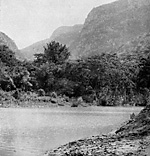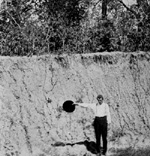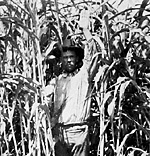| The Valley of Paradise Pamphlet |
| Alice & Lee Taylor Collection |
Read the entire pamphlet cover to cover |
|
|
 |
A LAND OF
SCENIC BEAUTY, CONTENTMENT,
HEALTH AND
GREAT OPPORTUNITY
ONE OF NATURE’S BEAUTY SPOTS
Who wouldn't want to live there? That was the snapshot description of the Chamal Valley in Tamaulipas, Mexico, as reported in "The Valley of Paradise" an advertising pamphlet published in 1911. The pamphlet published at the behest of the Valley of Paradise Development Association sought to advertise the assets of the Chamal Valley to "...the investor and the public in general." Lewis E. Medlin, Sam Johnson, and F. W. Musgrove, all Blalock Mexico Colony colonists, were the association's president, secretary, and treasurer respectively. These men and others were interested in promoting the assets of the valley to a wider audience.
The pamphlet extolled at length the valley's assets, which included a large amount of fertile land in a beautiful, healthy, opportunity rich environment. Images of the valley adorn the pages of the pamphlet with many locals, including W.R. Derr and W.W. Snell, serving as models showcasing the varied foliage and beauty of the valley. According to the promoters, the valley was none other than a ".veritable 'Garden of Eden." It was described as a ".delightful mountain pocket(s) or basin(s) 1,200 feet in altitude, consisting of 80,000 acres choice surveyed land." Its "oblong shape" was roughly eight miles wide and eighteen miles long and surrounded by "picturesque mountains." The fertile soil was described as being lain down over a long period of time by the eastward flow of the Bouquilla River into a "mammoth mountain lake" which was eventually released through the eastern mountain range. The accumulated soil varied in depth from two to thirty feet.
The pamphlet described the Chamal Valley as having clear and discrete rainy and dry seasons in contrast with locations in the United States. It was rainy for the long growing season needed to plant and cultivate but dry and manageable when it was time to harvest crops and get them to market. The temperatures in Kansas and Chamal were compared for ten days in July and August during the heat wave of 1910. The temperature in Kansas was hotter than in the valley on each of those ten summer days. According to the pamphlet the climate was so glorious that even cyclones are "unknown in this part of the world."
It was suggested that any crop, and more, that could be grown in California could be grown in the valley. All crops were said to grow at a faster rate and to greater height than any in the states. Common crops included oranges, corn, lemons, cane, and many more.
The promoters explained that as to workers the Peon, the ".native Indian of Mexico" was a "splendid laborer" who did not hold land, owing to his "improvident" nature, but was one anxious to be guided by the "intellect" of the "white man." These people only worked for wages, found their own lodgings, and were ".a good class." This ".labor is plentiful, and cheaper than slavery."
Another strength of the valley was its central location in Mexico. It was between a natural prosperous port, Tampico, a well-populated and hungry capital city, Mexico City, and the safety of US territory, Brownsville, Texas. One aspect of the physical location included the valley's 35-mile distance from the nearest train station at Arguelles.
The pamphlet revealed that the valley needed "more live people", to join its 70 American families from many US states already living there. It also needed a bank, local telephone, sawmill, well driller, gristmill, railroad and more. These items were what the valley and its residents needed, but the valley would provide, ".a tonic to a rundown, nervous system, restoring it almost immediately, while a short residence here has positively cured every case of catarrh, asthma, consumption, and all other bronchial troubles ever coming here."
The promoters explained that the value of the land had increased by 400% in the last eight years, but that the price was still lower than other areas due to the lack of development in the valley. They disclosed a secret that several railroad lines were interested in building to the valley. So now would be the best time to buy.
Members of the Valley of Paradise Association were willing to assist those interested in visiting the valley by arranging transportation from the train station and showing visitors around the valley. They wanted people to know that the Chamal Valley was an ideal place for a vacation, a business investment, or a permanent residence.
|
 |
| |
|
 |
 |
| |
|
 |
 |
| |
|
 |
 |
| |
|
 |
 |
|
| Page 1, 2, 3, 4, 5, 6, 7, 8, 9, 10, 11, 12, 13, 14, 15, 16, 17, 18, 19, 20, 21, 22, 23, 24, 25, 26, 27, 28, 29, 30, 31, 32 |
|
Return to Documents Page |
Site & Content Copyright© 2010 The Blalock Mexico Project
|









